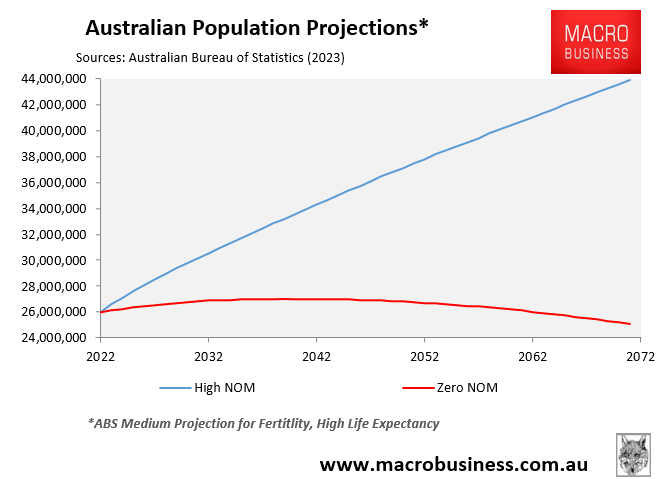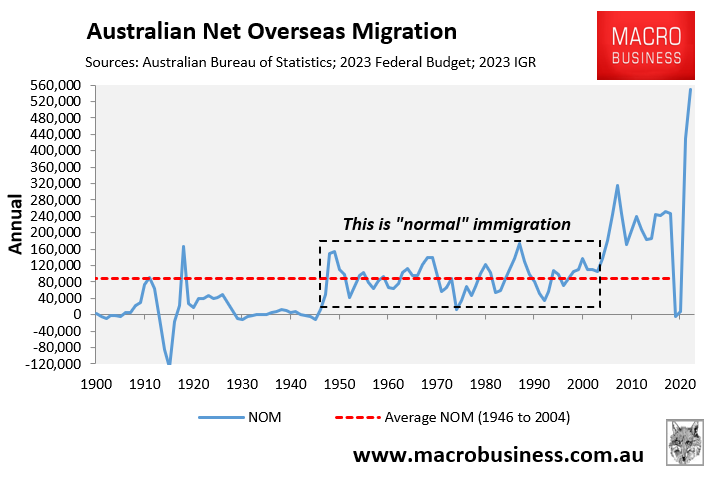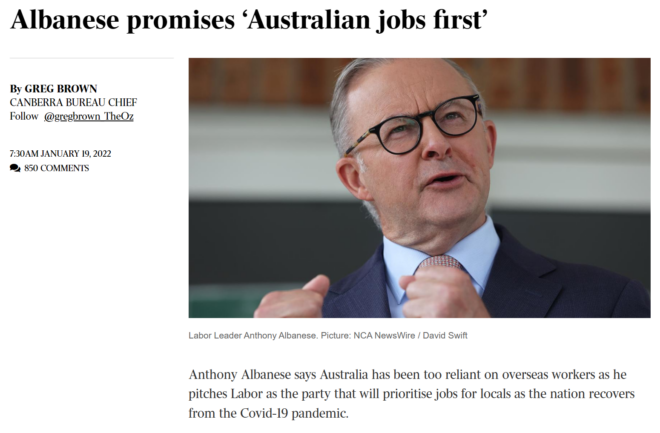Alan Kohler published an article this week arguing that the massive rise in immigration-driven population growth over the past two decades has driven Australia’s housing crisis.

While I agree with Kohler’s conclusion that immigration must be reduced “to something approaching the actual capacity of the construction industry to build houses for them all”, he also strangely argued that “the problem with immigration is that the government doesn’t control it”.
Kohler’s central argument is that because most people come to Australia on temporary visas, and the federal government doesn’t cap temporary visa numbers, the nation’s immigration is out of the government’s control.
I could not disagree with Kohler more.
If the federal government didn’t control migration numbers, we wouldn’t see the business lobby and pro-migration groups constantly advocating for increased immigration. We also would not have seen such a strong backlash from these same groups to Dutton’s planned permanent migrant cut or the bipartisan agreement to curb international student numbers.
Why would these groups bother lobbying the federal government if it has no control over immigration numbers?
The reality is that Australia’s population has ballooned by 8.3 million people this century. Over that time, Australia has granted 4 million permanent migration visas (including the humanitarian intake). This dwarfs the growth of temporary visas, whose stock currently stands at 2.4 million (excluding visitors).

Temporary residents are by definition temporary. Unless they can convert to permanent residency, temporary migrants will eventually have to leave, even if it takes many years.
As such, it is the permanent migrant intake that is the main driver of Australia’s population growth.
The permanent intake is what grows the population base over time, both directly and indirectly as permanent migrants have children (counted as ‘natural increase’).
To really emphasise my points, let’s conduct a thought experiment. If Australia theoretically slashed the permanent migrant intake to zero, there would be three main impacts on population growth:
- The flow of temporary migrants would be reduced since many migrants enter Australia on temporary visas first hoping to transition to a permanent non-humanitarian visa (capped at 185,000 for next financial year). Reducing permanent visas to zero, therefore, would eliminate the probability of gaining permanent residency and, therefore, reduce the incentive to come to Australia as a temporary migrant.
- The temporary migrants that cannot transition to permanent residency because the permanent intake has closed would have to leave Australia. This would lower net overseas migration (NOM) and population growth as outflows of temporary migrants exceed inflows.
- Fewer permanent residents means fewer migrants having children, thereby reducing natural increase.
Therefore, if the permanent migrant intake was hypothetically reduced to zero, then all temporary migrants would eventually have to leave, inflows would roughly match outflows over the longer-term, and NOM and by extension Australia’s population would flatline:

Therefore, it is wrong for Alan Kohler to claim that the government doesn’t control immigration when they literally set immigration policy.
Kohler’s article also blamed Australia’s high immigration intake on Coalition policies, ignoring that Labor has taken direct actions to juice migration numbers and also holds the two records for Australia’s NOM (i.e., 2008-09 under Kevin Rudd and the current episode).

For example, changes implemented by the Albanese government to boost immigration included:
- Increasing the permanent migrant intake by 30,000.
- Increasing the humanitarian intake by 7,000.
- Spending $42 million to hire 400 additional staff at the Department of Home Affairs to accelerate visa approvals.
- Prioritising offshore visa applications over onshore.
- Increasing the number of hours that international students can work in Australia to 24 hours a week, from 20 hours pre-pandemic.
- Issuing 66,000 “pandemic event visas” rather than abolishing the visas given the pandemic was over. Labor issued more of these special visas in its first 10 months than the Coalition granted over the 20 months before international borders began reopening in November 2021.
- Increasing the number of years that international students graduates can work in Australia post-study (revoked this year).
- Issuing more permanent visas for low-skilled workers in agriculture and aged care.
- Signing two migration deals with India to make it easier for Indians to study and work in Australia.
Heck, former immigration minister Andrew Giles literally boasted about the record numbers of visas approved by Labor:

Sure, Labor is now trying to clean up its own mess by cracking down on the blowout in students, but Kohler should at least acknowledge that Big Australia immigration is bipartisan policy.
The Albanese government merely took immigration to a new level, despite promising before the election that it would run a lower immigration policy.



